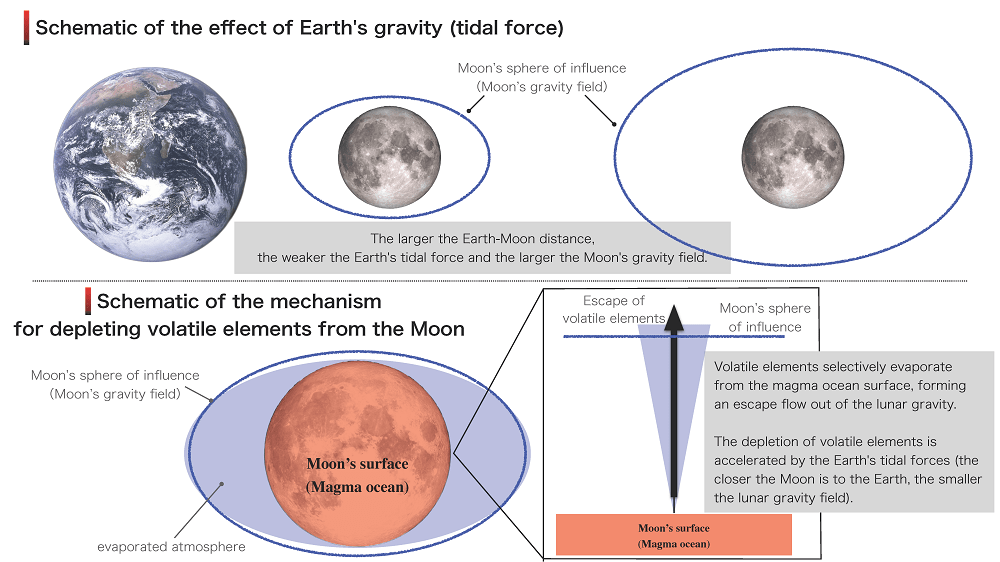Mechanism for depleting volatile elements from the Moon revealed
Jul. 16, 2021 | GATEWAY to Academic Articles
It is believed that the Moon was formed as a byproduct of the last giant impact on Earth. However, the full extent of the giant impact (e.g., the initial state of the Moon when it was formed) is still shrouded in mystery. Analysis of the samples brought back from the Moon by NASA astronauts (the Apollo samples) revealed that the building blocks of the Moon and the Earth are very similar, but volatile elements have been depleted from the Moon. This is thought to be a result of the formation process of the Moon, but what physicochemical processes caused the depletion of volatile elements is an open question. In this study, by constructing a new model of evaporative atmospheric escape from the surface of the lunar magma ocean, the authors succeeded in explaining the degree of depletion of volatile elements (K and Na) obtained from the Apollo samples. The study suggests that the Moon existed at a distance of about 3-6 times the Earth's radius from the Earth (currently about 60 times) with a global magma ocean temperature of about 1600~1700 K for less than 1,000 years after its formation.
Research Summary
It is believed that the Moon was formed as a byproduct of the last giant impact*1 on Earth. Immediately after its formation, it is thought that the Moon was located close to the Earth (about 3~6 times the Earth's radius; about 60 times today) with its surface was covered by a global magma ocean*2. In this study, the authors developed a new model of evaporative atmospheric escape from the lunar surface under such conditions. The composition of the evaporating atmosphere for a given pressure and temperature was investigated using the BSE material (Bulk Silicate Earth)*3 using laboratory experiments and thermodynamic calculations. The atmospheric escape model was constructed by applying the model of the solar wind (Parker solution) to the lunar magma ocean. The authors found the conditions for the existence of an intense hydrodynamic escape from the molten lunar surface (towards outside the lunar gravity sphere). In this study, the authors searched for thermodynamic (e.g., magma ocean temperature and its duration) and dynamical (e.g., Earth-Moon distance) conditions under which the degree of volatile depletion reported in the Apollo samples is achieved, using the BSE material as the initial material (see Figure).
The authors revealed that the conditions that could explain the degree of volatile depletion (K and Na) in the Apollo samples are (1) a period of about less than 1,000 years, (2) a lunar magma ocean of about 1,600~1,700 K, and (3) the Moon being located at about 3~6 times the Earth radius from the Earth. All of these conditions have been reported to be possible in previous studies. The higher temperature (or longer duration of existence) of the magma ocean would result in the disappearance of more volatile elements from the Moon than observed. If the distance between the Moon and the Earth is greater, the effect of the Earth's gravity around the Moon will be less, and the evaporative atmosphere will be more strongly trapped by the lunar gravity, so that the depletion of volatile elements will not occur as efficiently. (In technical terms, as the Hill sphere of the Moon enlarges with the Earth-Moon distance, the Earth's tidal forces become less effective, making it more difficult for the evaporating atmosphere to escape from lunar gravity; see Figure).

In the study, the authors discovered a new physicochemical mechanism that selectively depletes volatile elements from satellites in the vicinity of planets such as the Moon. In addition, this study has placed constraints on the surface temperature and location of the Moon immediately after formation. By comparing the results with those of the giant impact and the lunar accumulation process, we expect to gain a deeper understanding of the constraints of the giant impact that formed the Moon and the ancient accumulation environment in the solar system.
The constraint of the thermodynamic conditions immediately after the formation of the Moon will help us to understand the origin and evolution of water, which is an important volatile material for human lunar exploration programs. Since this study does not take into account the existence of water in the magma ocean, future studies on the early evolution of the Moon that take water into account will be necessary. It is also expected that there might be a bias in our Apollo samples (currently they are limited to samples from certain regions). For further understanding of the Moon and detailed validation of the models, we need samples from multiple locations from future lunar missions.
Terminologies
- *1 Giant impact: a giant collision event between celestial bodies. Classically, the Moon is thought to have been formed by a Mars-sized object colliding with the ancient Earth. However, various models (a variety of combinations of the sizes and velocities of the colliding bodies) have been proposed, and the full extent of the giant impact that formed the Moon has yet to be elucidated.
- *2 Magma ocean: a situation in which the surface of a celestial body is melted and covered with magma.
- *3 Bulk Silicate Earth (BSE): a primitive composition of the Earth’s mantle.
- *4 Gas drag: a drag force operating on a body moving through a gaseous medium, which causes the body to lose momentum and energy.
- *5 Radiation pressure: pressure caused by photons striking the surface of solid particles. Here, the Earth's surface is also a magma ocean, referring to the radiation pressure from the Earth.
Information
| Journal Title | Icarus |
|---|---|
| Full title of the paper | Tidal pull of the Earth strips the proto-Moon of its volatiles |
| DOI | https://doi.org/10.1016/j.icarus.2021.114451 |
| Publish date | 3 April 2021 |
| Author(s) | Sébastien Charnoz (Université de Paris, Institut de Physique du Globe de Paris, CNRS), Paolo A. Sossi (Institute of Geochemistry and Petrology, ETH Zürich), Yueh-Ning Lee (Department of Earth Sciences, National Taiwan Normal University), Julien Siebert (Université de Paris, Institut de Physique du Globe de Paris, CNRS), Ryuki Hyodo (ISAS, JAXA), Laetitia Alliber (Université de Paris, Institut de Physique du Globe de Paris, CNRS), Francesco C. Pignatal (Université de Paris, Institut de Physique du Globe de Paris, CNRS), Maylis Landeau (Université de Paris, Institut de Physique du Globe de Paris, CNRS), Apurva V. Oza (Physikalisches Institut, Universität Bern), Frédéric Moynier (Université de Paris, Institut de Physique du Globe de Paris, CNRS) |
| ISAS or JAXA member(s) among author(s) | HYODO Ryuki (Dept. of Solar System Sciences) |


 HYODO Ryuki / Dept. of Solar System Sciences, ISAS
HYODO Ryuki / Dept. of Solar System Sciences, ISAS